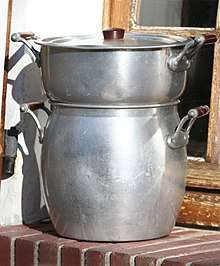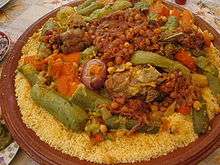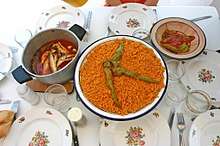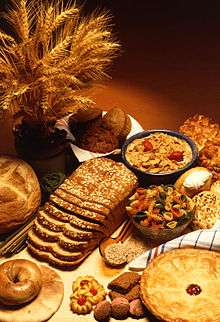Couscous
|
Couscous served with vegetables and chickpeas | |
| Place of origin | Maghreb[1] |
|---|---|
| Main ingredients | Semolina |
Couscous (Arabic: كُسْكُس kuskus ; Berber languages: ⵙⵉⴽⵙⵓ seksu) is a Maghrebi dish of small (about 3 millimetres (0.12 in) diameter) steamed balls of crushed durum wheat semolina[2] that is traditionally served with a stew spooned on top. Pearl millet and sorghum especially in the Sahel and other cereals can be cooked in a similar way and the resulting dishes are also sometimes called couscous.[3]:18[4]
Couscous is a staple food throughout the North African cuisines of Algeria, Morocco, Tunisia, Mauritania, Libya, and Egypt.[5][6]:250 In Western supermarkets, it is typically sold in instant form with a flavor packet, and may be served as a side or on its own as a main dish.
Etymology
The original name may be derived from the Arabic word Kaskasa, meaning "to pound small" or the Berber Seksu, meaning "well rolled", "well formed", or "rounded".[7]
Numerous different names and pronunciations for couscous exist around the world. Couscous is /ˈkʊskʊs/ or /ˈkuːskuːs/ in the United Kingdom and only the latter in the United States. It is sometimes pronounced kuskusi (كسكسي) in Arabic, while it is known in Morocco as seksu ; kesksu or (كسكسي ; in Algeria as kosksi ' (طعام, literally meaning "food") ; in Tunisia and Libya kosksi or kuseksi , in Egypt kuskusi (كسكسي), Sicily cuscusu and keskes in Tuareg.[8]:919
Origin and history
The origin of couscous appears to be in the region from eastern to northern Africa where Berbers used it as early as the 7th century.[9][10] Recognized as a traditional North African delicacy, it is a common cuisine component among Maghreb countries.[9][10]
Ibn Battuta (b. Morocco, 1304-1368? AD) stated in his Rihlah (Travels), indicating what may be the earliest mention of couscous (kuskusu) in West Africa from the early 1350s:
When the traveler arrives in a village the women of the blacks come with anlî and milk and chickens and flour of nabaq [lotus], rice, and fûnî fonio [a type of millet], this is like the grain of mustard and from it kuskusu and porridge are made, and bean flour. He buys from them what he likes, but not rice, as eating the rice is harmful to white men and the fûnî is better than it.[11]:32
Preparation
Couscous was traditionally made from the hard part of the durum, the part of the grain that resisted the grinding of the millstone. The semolina is sprinkled with water and rolled with the hands to form small pellets, sprinkled with dry flour to keep them separate, and then sieved. Any pellets that are too small to be finished granules of couscous fall through the sieve and are again rolled and sprinkled with dry semolina and rolled into pellets. This labor-intensive process continues until all the semolina has been formed into tiny granules of couscous. In the traditional method of preparing couscous, groups of women came together to make large batches over several days, which were then dried in the sun and used for several months. Handmade couscous may need to be rehydrated as it is prepared; this is achieved by a process of moistening and steaming over stew until the couscous reaches the desired light and fluffy consistency. [12]
In some regions couscous is made from Farina or coarsely ground barley or pearl millet. In Brazil, the traditional couscous is made from cornmeal.[13]

In modern times, couscous production is largely mechanized, and the product is sold in markets around the world. This couscous can be sauteed before it is cooked in water or another liquid.[12] Properly cooked couscous is light and fluffy, not gummy or gritty. Traditionally, North Africans use a food steamer (called aTaseksut in Berber, a كِسْكَاس kiskas in Arabic or a couscoussier in French). The base is a tall metal pot shaped rather like an oil jar in which the meat and vegetables are cooked as a stew. On top of the base, a steamer sits where the couscous is cooked, absorbing the flavours from the stew. The lid to the steamer has holes around its edge so steam can escape. It is also possible to use a pot with a steamer insert. If the holes are too big, the steamer can be lined with damp cheesecloth. There is little archaeological evidence of early diets including couscous, possibly because the original couscoussier was probably made from organic materials that could not survive extended exposure to the elements.
Instant couscous
The couscous that is sold in most Western supermarkets has been pre-steamed and dried. It is typically prepared by adding 1.5 measures of boiling water or stock to each measure of couscous then leaving covered tightly for about five minutes. Pre-steamed couscous takes less time to prepare than regular couscous, most dried pasta, or dried grains (such as rice).
Local serving variations

In Tunisia, Algeria, Morocco, and Libya, couscous is generally served with vegetables (carrots, potatoes, turnips, etc.) cooked in a spicy or mild broth or stew, and some meat (generally, chicken, lamb or mutton). In the Sahelian countries of West Africa, such as Mali and Senegal, pearl millet is pounded or milled to the size and consistency necessary for the couscous.[14][3]
In Algeria and Morocco it is also served, sometimes at the end of a meal or just by itself, as a delicacy called "sfouff". The couscous is usually steamed several times until it is very fluffy and pale in color. It is then sprinkled with almonds, cinnamon and sugar. Traditionally, this dessert is served with milk perfumed with orange flower water, or it can be served plain with buttermilk in a bowl as a cold light soup for supper.
In Tunisia, it is made mostly spicy with harissa sauce and served with almost everything, including lamb, fish, seafood, beef and sometimes in southern regions, camel. Fish couscous is a Tunisian specialty and can also be made with octopus, squid or other seafood in hot, red, spicy sauce. Couscous in Tunisia is served on every occasion; it is also served in some regions (mostly during Ramadan), sweetened as a dessert called masfouf.
In Libya, it is mostly served with meat, specifically mostly lamb, but also camel, and very rarely beef, in Tripoli and the western parts of Libya, but not during official ceremonies or weddings. Another way to eat couscous is as a dessert; it is prepared with dates, sesame, and pure honey, and locally referred to as "maghrood".
Couscous is also very popular in France, where it is now considered a traditional dish, and has also become common in Spain, Portugal, Italy, and Greece. Indeed, many polls have indicated that it is often a favorite dish.[15] Couscous is served in many Maghrebi restaurants all over the world. In France, Spain and Italy, the word "couscous" (cuscús in Spanish and Italian; cuscuz in Portuguese) usually refers to couscous together with the stew. Packaged sets containing a box of quick-preparation couscous and a can of vegetables and, generally, meat are sold in French, Spanish and Italian grocery stores and supermarkets. In France, it is generally served with harissa sauce, a style inherited from the Tunisian cuisine. Indeed, couscous was voted as the third-favourite dish of French people in 2011 in a study by TNS Sofres for magazine Vie Pratique Gourmand, and the first in the east of France.[16][17]

Couscous with fish soup is a traditional dish in Trapani, Sicily.
Israelis typically serve it on occasions and holidays. It was brought by Maghrebi migrants from Tunisia, Algeria, Morocco and Libya to Israel. In Egypt, couscous is eaten more as a dessert. It is prepared with butter, sugar, cinnamon, raisins, and nuts and topped with cream. In Palestine, maftoul is considered as a special type of couscous but made from different ingredients and a different shape. It is larger than North African couscous, but is similarly steamed and often served on special occasions in a chicken broth with garbanzo beans and tender pieces of chicken taken off the bone. Maftoul is an Arabic word derived from the root "fa-ta-la", which means to roll or to twist, which is exactly describing the method used to make maftoul by hand rolling bulgur with wheat flour.[18] Maftoul is a special dish in Palestinian cuisine and not every cook knows how to prepare it. In fact, there is an annual Maftoul Festival which involves a competition held in Bir Zeit every year.
Couscous may be used to make a breakfast tabbouleh salad. Though usually cooked it water, it can also be cooking in another liquid, like apple juice, and served with dried fruit and honey.[12]
Nutrition
| Serving size 1 cup (173 g) | |||
| Servings per container Information is per cooked wheat couscous as determined by Nutrient Data Laboratory, ARS, USDA.[19] | |||
| Amount per serving | |||
| Calories 176 | Calories from fat 2 | ||
| % Daily value* | |||
| Total fat 0.25 g | 0% | ||
| Saturated fat 0.05 g | 0% | ||
| Trans fat 0 g | |||
| Cholesterol 0 mg | 0% | ||
| Sodium 8 mg | 0% | ||
| Potassium 91 mg | 3% | ||
| Total carbohydrate 36 g | 12% | ||
| Dietary fiber 2 g | 1% | ||
| Sugars 0 g | |||
| Protein 6 g | |||
| Vitamin A | 0% | Vitamin C | 0% |
| Calcium | 1% | Iron | 2% |
| *Percent daily values are based on a 2,000‑calorie diet. Your daily values may be higher or lower depending on your calorie needs. | |||
In a one cup reference amount, wheat couscous provides 6 grams of protein, 36 grams of carbohydrates, and negligible fat.
Similar foods
Couscous is distinct from pasta, even pasta such as orzo and risoni of similar size, in that it is made from crushed durum wheat semolina, while pasta is made from ground wheat. Couscous and pasta have similar nutritional value, although pasta is usually more refined. Pasta is cooked by boiling and couscous is steamed.[2] Burghul or bulgur is a kind of parboiled dried cracked wheat of similar size to couscous, cooked by adding boiling water and leaving for a few minutes to soften.
- Attiéké is a variety of couscous that is a staple food in Côte d'Ivoire and is also known to surrounding regions of West Africa, made from grated cassava.
- Berkoukes are pasta bullets made by the same process but are larger than the grains of couscous.
- In Brazilian cuisine, the "cuscuz marroquino" is a version, usually eaten cold, of the "couscous". Brazilian cuscuz is usually made out of cornmeal rather than semolina wheat. Another festive moulded couscous dish containing chicken, vegetables, spices, steamed in a mould and decorated with orange slices is called "Cuscuz de Galinha".
- Kouskousaki (Κουσκουσάκι in Greek or kuskus in Turkish), a pasta from Greece and Turkey, that is boiled and served with cheese and walnuts.
- In Lebanese cuisine, Jordanian cuisine and Palestinian cuisine, a similar but larger product is known as maftoul or moghrabieh.
- Upma, eaten in South India, Western India, and Sri Lanka is a thick porridge made with dry roasted semolina. It also uses vegetables such as peas, carrots, etc.
- Ptitim is a type of toasted pasta shaped like rice grains or little balls developed in Israel in the 1950s when rice was scarce. Outside Israel, it is typically marketed as "Israeli couscous" or "pearl couscous".
- cuscuz (Portuguese pronunciation: [kusˈkus]), a popular recipe usually associated with Northeastern Brazil and its diaspora, a steamed cake of corn meal served alone or with sugar and milk, varied meats, cheese and eggs or other ingredients.
See also
References
- ↑ Wright, Clifford A. "Did You Know: Food History - History of Couscous". www.cliffordawright.com. Retrieved 9 August 2017.
- 1 2 Shulman, Martha Rose (23 February 2009). "Couscous: Just Don't Call It Pasta". The New York Times. Retrieved 12 June 2017.
- 1 2 Taylor, J.R.N.; Barrion, S.C.; Rooney, L.W. (2010). "Pearl Millet--New Developments in Ancient Food Grain" (PDF). Cereal Foods World. 55 (1): 16–19. doi:10.1094/CFW-55-1-0016. Retrieved 1 April 2018.
- ↑ "Codex Standards for Couscous: 202-1995". Food and Agriculture Organization of the United Nations. Retrieved 1 April 2018.
- ↑ Naylor, Phillip C. (2015). Historical Dictionary of Algeria. Rowman & Littlefield. p. 195. ISBN 978-0-8108-7919-5.
- ↑ Soletti, Francesco; Selmi, Luca (2006). Turismo gastronomico in Italia, Volume 1. Touring Club Italiano. ISBN 978-8836535002.
- ↑ Habeeb., Salloum, (2013). Scheherazade's feasts : foods of the medieval Arab world. Salloum, Muna., Elias, Leila Salloum. (1st ed.). Philadelphia: University of Pennsylvania Press. p. 93. ISBN 081224477X. OCLC 806981280.
- ↑ Foucauld, Charles de (1950–1952). Dictionnaire touareg-français : dialecte de l'Ahaggar (in French). Paris: Impr. nationale de France.
- 1 2 Mustafa Ettoualy (29 June 2012). "Moroccan Couscous and Tagine". Moroccan World News. Retrieved 23 January 2018.
- 1 2 "Couscous". Encyclopedia of Food and Culture, The Gale Group Inc. 2003. Retrieved 23 January 2018.
- ↑ Hamdun, Said (1975). King, Noel Quinton, ed. Ibn Battuta in Black Africa. London: Collings. ISBN 9780901720573.
- 1 2 3 Asbell, Robin (2011-11-18). The New Whole Grain Cookbook: Terrific Recipes Using Farro, Quinoa, Brown Rice, Barley, and Many Other Delicious and Nutritious Grains. Chronicle Books. ISBN 978-1-4521-0042-5.
- ↑ "Receitas". revistagloborural.globo.com. Archived from the original on January 29, 2008. Retrieved August 9, 2017.
- ↑ Sivak MN. Starch: Basic Science to Biotechnology. Academic Press, 1998, ISBN 0-12-016441-8, p. 132
- ↑ Study conducted on January 11 and 12, 2006, for the magazine Notre Temps based on face-to-face interviews with a sample of 1,000 people representative of the adult French population, stratified by age, sex, profession of the head of household, region and type of municipality.
- ↑ Les plats préférés des Français Archived April 8, 2012, at the Wayback Machine., enquête réalisée en août 2011 pour le magazine Vie Pratique Gourmand auprès d'un échantillon national de 999 personnes représentatif de l'ensemble de la population âgée de 18 ans et plus, interrogées en face à face. Méthode des quotas (sexe, âge, profession du chef de ménage PCS) et stratification par région et catégorie d’agglomération.
- ↑ France, Connexion. "Magret is the No1 dish for French". www.connexionfrance.com. Retrieved 2018-02-05.
- ↑ "Kitchen of Palestine Palestinian Couscous (Maftoul) -". www.kitchenofpalestine.com. Retrieved 9 August 2017.
- ↑ Couscous, dry – NDB No: 20028 Archived March 3, 2015, at the Wayback Machine. United States Department of Agriculture National Nutrient Database for Standard Reference. Retrieved December 18, 2007.
| Wikimedia Commons has media related to Couscous. |
| Wikibooks Cookbook has a recipe/module on |
